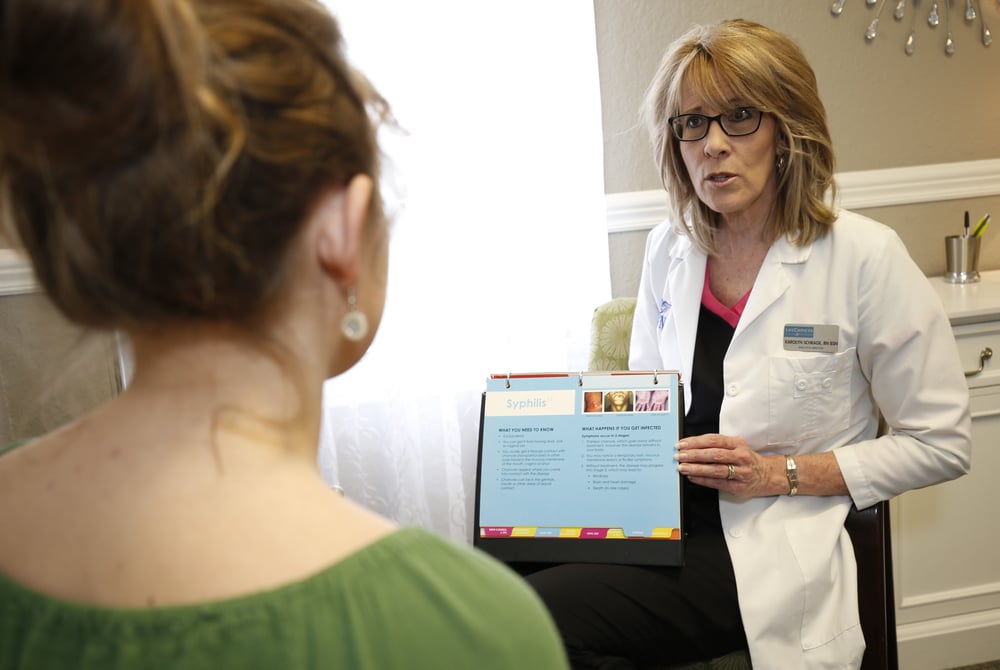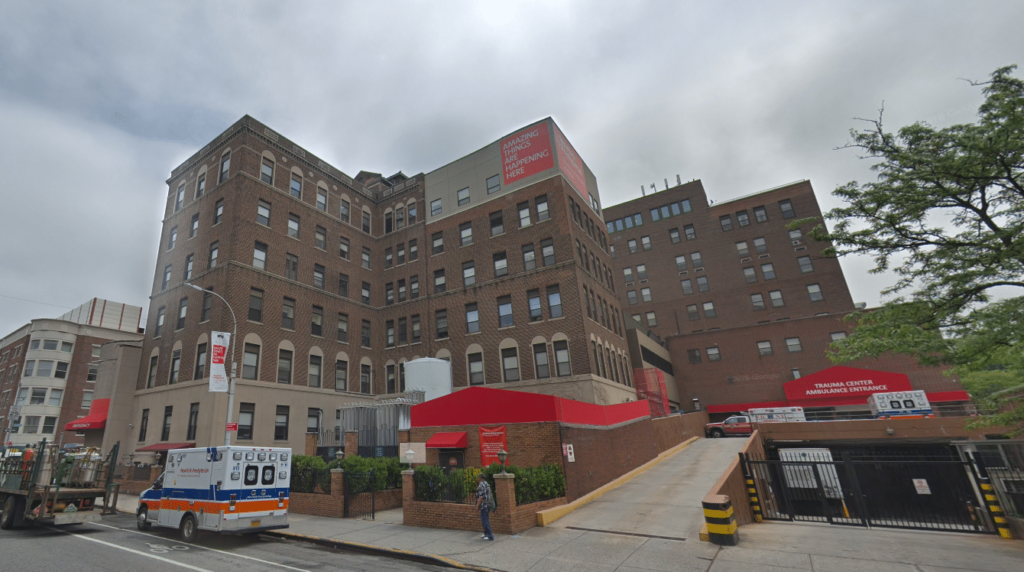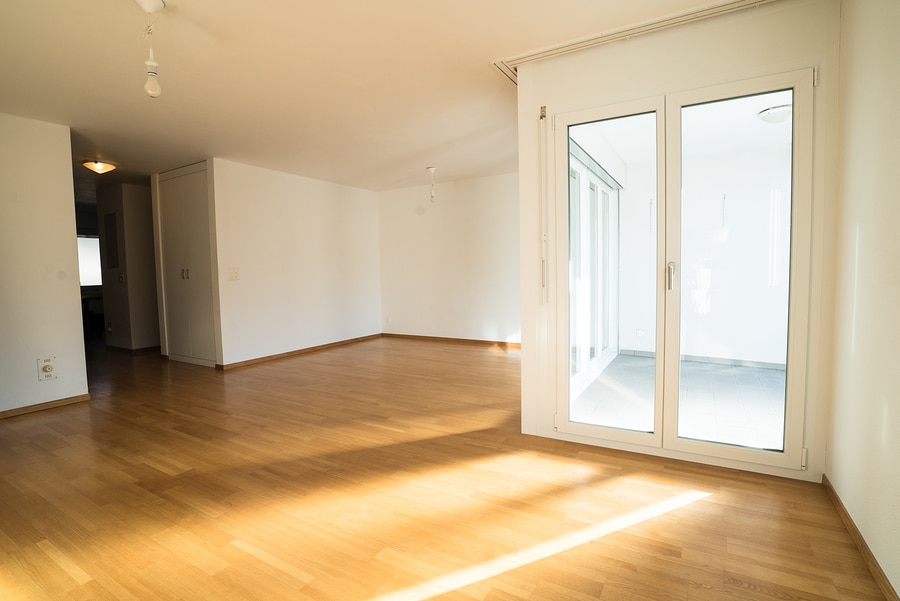As Syphilis Invades Rural America, A Fraying Health Safety Net Is Failing To Stop It (KHN)

By Lauren Weber, Kaiser Health News When Karolyn Schrage first heard about the “dominoes gang” in the health clinic she runs in Joplin, Mo., she assumed it had to do with pizza. Turns out it was a group of men in their 60s and 70s who held a standing game night — which included sex with one another. They showed up at her clinic infected with syphilis. That has become Schrage’s new normal. Pregnant women, young men and teens are all part of the rapidly growing number of syphilis patients coming to the Choices Medical Services clinic in the rural southwestern corner of the state. She can barely keep the antibiotic treatment for syphilis, penicillin G benzathine, stocked on her shelves. Public health officials say rural counties across the Midwest and West are becoming the new battleground. While syphilis is still concentrated in cities such as San Francisco, Atlanta and Las Vegas, its continued spread into places like Missouri, Iowa, Kansas and Oklahoma creates a new set of challenges. Compared with urban hubs, rural populations tend to have less access to public health resources, less experience with syphilis and less willingness to address it because of socially conservative views toward homosexuality and nonmarital sex. In Missouri, the total number of syphilis patients has more than quadrupled since 2012 — jumping from 425 to 1,896 cases last year — according to a Kaiser Health News analysis of new state health data. Almost half of those are outside the major population centers and typical STD hot spots of Kansas City, St. Louis and its adjacent county. Syphilis cases surged at least eightfold during that period in the rest of the state. At Choices Medical Services, Schrage has watched the caseload grow from five cases to 32 in the first quarter of 2019 alone compared with the same period last year. “I’ve not seen anything like it in my history of doing sexual health care,” she said. Back in 1999, the Centers for Disease Control and Prevention had a plan to eradicate the sexually transmitted disease that totaled over 35,000 cases nationwide that year. While syphilis can cause permanent neurological damage, blindness or even death, it is both treatable and curable. By focusing on the epicenters clustered primarily throughout the South, California and in major urban areas, the plan seemed within reach. Instead, U.S. cases topped 101,500 in 2017 and are continuing to rise along with other sexually transmitted diseases. Syphilis is back in part because of increasing drug use, but health officials are losing the fight because of a combination of cuts in national and state health funding and crumbling public health infrastructure. “It really is astounding to me that in the modern Western world we are dealing with the epidemic that was almost eradicated,” said Schrage. Grappling With The Jump Craig Highfill, who directs Missouri’s field prevention efforts for the Bureau of HIV, STD and Hepatitis, has horror stories about how syphilis can be misunderstood. “Oh, no, honey, only hookers get syphilis,” he said one rural doctor told a patient who asked if she had the STD after spotting a lesion. In small towns, younger patients fear that their local doctor — who may also be their Sunday school teacher or basketball coach — may call their parents. Others don’t want to risk the receptionist at their doctor’s office gossiping about their diagnosis. Some men haven’t told family members they’re having sex with other men. And still more have no idea their partner may have cheated on them — and their doctors don’t want to ask, according to Highfill. It’s even hard to expect providers who haven’t seen a case of syphilis in their lifetime to automatically recognize the hallmarks of what is often called the “great imitator,” Highfill said. Syphilis can manifest differently among patients, but frequently shows up for a few weeks as lesions or rashes — often dismissed by doctors who aren’t expecting to see the disease. Since 2000, the current syphilis epidemic was most prevalent among men having sex with men. Starting in 2013, public health officials began seeing an alarming jump in the number of women contracting syphilis, which is particularly disturbing considering the deadly effects of congenital syphilis — when the disease is passed from a pregnant woman to her fetus. That can cause miscarriage, stillbirth or birth deformities. Among those rising numbers of women contracting syphilis and the men who were their partners, self-reported use of methamphetamines, heroin or other intravenous drugs continues to grow, according to the CDC. Public health officials suggest that increased drug use — which can result in a pattern of risky sex or trading sex for drugs — worsens the outbreaks. That perilous trend is playing out particularly in rural Missouri, argues Dr. Hilary Reno, an assistant professor of medicine at Washington University School of Medicine in St. Louis who is researching syphilis transmission and drug use in the state. Tracking cases from 2015 through June 2018, she found that more than half of patients outside of the major metropolitan areas of Kansas City and St. Louis reported using drugs. Less Money, More Problems Federal funding for STD prevention has stayed relatively flat since 2003, with $157.3 million allocated for fiscal year 2018. But that amounts to a nearly 40% decrease in purchasing power over that time, according to the National Coalition of STD Directors. In Missouri, CDC annual funding has been cut by over $354,000 from 2012 to 2018 — a 17% decrease even as the number of cases quadrupled, Highfill said. Iowa, too, has seen its STD funding cut by $82,000 over the past decade, according to Iowa Department of Health’s STD program manager George Walton. “It is very difficult to get ahead of an epidemic when case counts are steadily — sometimes rapidly — increasing and your resources are at best stagnant,” Walton said. “It just becomes overwhelming.” Highfill bemoaned that legislatures in Texas, Oregon and New York have all allocated state money to raise
‘Sorry, I Don’t Have Any 8’s’: Nurses Slam State Senator On Social Media For ‘Nurses Play Cards’ Comments

UPDATE, 10:26 a.m., April 24, 2019 Washington Sen. Maureen Walsh released an official statement on the Washington State Senate Republican Caucus Website, apologizing for her comments last Tuesday. “I really don’t believe nurses at our critical access hospitals spend their days playing cards, but I did say it, and I wish I could reel it back,” Walsh said in the statement. You can read her full statement here: http://maureenwalsh.src.wastateleg.org/walsh-issues-statement-regarding-house-bill-1155/ Comments made by Washington Sen. Maureen Walsh during a recent debate about a bill regarding breaks and overtime for nurses spawned a massive wave of negative reactions over the weekend. Walsh made the comments during a Senate floor debate on Tuesday in opposition to SHB 1155, which would require uninterrupted meals and rest periods and would provide for stronger protections against mandatory overtime. Walsh argued for an amendment to the bill that would exclude rural critical access care hospitals, and said it would make it more difficult for those facilities to stay open. “By putting these types of mandates on a critical access hospital that literally serves a handful of individuals, I would submit to you those nurses probably do get breaks,” Walsh said. “They probably play cards for a considerable amount of the day.” The online backlash to Walsh’s comments from nurses around the country was swift and significant. Nurses and healthcare workers shared thousands of memes, Instagram posts, YouTube reaction videos and more over the Easter weekend in response, using hashtags #maureenwalsh and #nursesplaycards. A blog post condeming Walsh from the Washington State Nurses Association caused the organization’s website to crash over the weekend, as too many people tried to view the post at once, according to a USA Today report. “No, Senator, nurses are not sitting around playing cards. They are taking care of your neighbors, your family, your community,” Matthew Keller, WSNA’s director of nursing practice and health policy, said in the blog post. “And they do read the research: mandatory overtime is bad for patient care and it’s bad for your rural hospitals. With all due respect, Sen. Walsh: perhaps it’s time for you to put down the cards and pick up the literature.” Supporters created two petitions on Change.org, one calling for Walsh to shadow a nurse for a 12-hour shift, and another calling for her resignation. The shadowing petition had about 5,000 signatures by noon Saturday and has climbed to more than 560,000 as of Monday morning. Walsh told Tri-City Herald she regretted her comment and didn’t have any malicious intent when it was made. “I was tired,” Walsh said. “I said something I wish I hadn’t.” Walsh still supports an amendment to the bill that would exclude nurses at hospitals with fewer than 25 beds from uninterrupted breaks. An unamended version of the bill already passed through the state’s House, but will have to be reconciled in the Senate following a voice vote approval of a seperate amendment that would restrict state nurses to only working 8-hour shifts.
NYC Nurses Vote To Ratify Contract For Increased Pay, Safe Staffing Ratios

A majority of union nurses that work at NewYork-Presbyterian hospitals voted Thursday to ratify a four-year contract with the hospital that includes the establishment of minimum staffing ratios among other provisions, according to a Facebook post from the New York State Nurses Association (NYSNA). About 91 percent of the nurses at the hospital voted to ratify the contract agreement, according to the post. NYSNA members and representatives from some of the state’s largest hospitals reached the tentative contract agreement last Tuesday, ending a months-long feud and preventing a major nurse strike. The four-year contract includes a $100 million agreement to hire nearly 1,000 additional staff members at New York-Presbyterian Hospital, Montefiore, and Mount Sinai hospitals, a minimum wage increase of three percent annually and an extended window for nurse retiree health benefits. The provision of the contract praised the most by supporters on social media—and that was often the source of escalating tension between union members and the hospitals—was the agreement to create unit-specific staffing grids that would establish minimum nurse-to-patient ratios. This is the first time minimum staffing levels have been “spelled out in the contract with a meaningful enforcement mechanism,” according to a press release from NYSNA. Once both parties agree on the minimum staffing levels, a third-party arbitrator will be responsible for enforcing those levels and changing them based on patient census and acuity changes, according to the contract. Anthony Ciampa, first vice president of the New York State Nurses Association told the New York Times this agreement marks a groundbreaking achievement in addressing staffing issues statewide. “This is going to have a very positive impact, and it will be the trendsetter of the industry,” Ciampa told New York Times. “What we decide in these major city hospitals tends to set the framework for other hospitals.” Details of the full agreement can be view below:
Stocking Up: 4 Ways To Cheaply Furnish Your Travel Nurse Short Term Rental

By Alex McCoy, Contributing Writer, Owner of Fit Travel Life Editor’s note: Stocking Up is a three-part miniseries that covers the essential travel items and furnishing methods Alex McCoy uses to make it feel more like home at each new travel assignment without breaking the bank. Click here to read part one, or click here to read part two. One of the best ways to save money on short term rentals is to do a little more leg work when it comes to furnishings, linens, or other household supplies. While fully furnished places might sound appealing, opting to furnish a rental yourself may be a great way to save money while on a travel nurse assignment. There are several ways to approach furnishing a short term rental, from bare bones furnishings up to move-in ready packages. This week I want to share some ways to save money while furnishing a rental yourself. These options won’t get you a decked-out crib, but hopefully, you will be able to weigh the pros, cons, and cost of each option and make the best decision for you. How To Furnish A New Rental As A Travel Nurse Option One: Bare bones furnishings. Most travel healthcare workers are minimalists at heart. If all of your belongings fit into your vehicle, chances are most of your life is pretty “no frills”. As a result, I have seen many travelers opt for the most basic of furnishings to save money and time. Many of these travelers will simply invest in a decent air mattress and use plastic tubs as tables in their home. They will sometimes buy inflatable couches or a cheap futon to act as a couch. Camp chairs also work well for watching TV or eating dinner if you want to avoid purchasing actual furniture. While this may seem extreme to some people, to others this is simply a practical way to live to save money. If you are not entertaining guests and sleep well on an inflatable bed, there may be no reason to spend money on any more furniture than what can fit in your car. Option Two: Purchase cheaply or find free furniture. Some travelers prefer to purchase gently used furniture at the beginning of each assignment or even find offers for free furniture on Facebook or Craigslist. One great way to source cheap furniture or other household items is to find a local traveler page for the city you are living in. By searching “City + Travel Nurses” on Facebook you can find a specific group for almost every major city in the United States. I have seen many furniture listings on such groups, and most travelers looking to sell will list their whole apartment as a lot for an incredibly low price. The downside to this option is having to then get rid of the furniture at the end of each assignment. However, it can be easy to simply offload possessions in the way you acquired them: by listing them for very cheap or free on different networks. This also requires some leg work the last few weeks of an assignment when you have to coordinate pick up times and meet-ups. One way to skip this hassle would be to simply donate items, or you could re-list as a lot for people to pick up in one go. Option Three: Rent cheap from a furniture store. If you go online and browse some of the more popular rental furniture stores, you will notice that a full apartment worth of rental pieces will run several hundred dollars. But what they don’t tell you is if you go in person to the store they will have a selection of gently used pieces that may not be as “pretty” as the online photos but will be just as functional. You don’t actually have to rent a full package—you can simply pick the basic necessities (think mattress, couch, coffee table, TV stand) and build your own perfect package. Some of these stores will even have furniture that can be sold and delivered for cheaper than renting it, but once again you will have to decide if purchasing and then reselling is worth the money you may save up front. Option Four: Scout out locally-owned furniture stores for deals. Last time we rented furniture ourselves, we found an incredible deal from a local furniture shop. We initially planned on just renting the basics, but the cost of an entire apartment worth of furniture was less than $200 so we splurged a little to make our place feel more like home. Because locally owned stores have less overhead they may be able to keep prices down. This is even more common in areas with large military bases where renting furniture is a much more common practice. These types of places may be easier to find in person once you arrive at your destination. You can simply plan on using an air mattress for the first couple of nights while checking out the local area for potential rental shops. Or, combine all of the above. Some travelers will simply rent or purchase a couch while sleeping on an air mattress and using a plastic bin for a TV stand. Regardless of how you make it work, all that matters is that you are comfortable and happy with your living space. By getting a little creative when deciding how to furnish your travel nurse apartment, you can skip the big prices and still end up with just what you need. Skip the major websites, look for local travelers offloading items, and itemize rather than renting full packages to save cash all around. Make note of what furniture you actually use on a regular basis rather than worrying about filling space, and it will be easy to see what the must-haves are for each assignment. << Part Two: Saving Money On Essentials For Your New Travel Home
Travel Healthcare Jobs: Market Healthy In April As Seasonal Shift Continues

It’s not just the grass that’s growing greener in April—recruiters and industry insiders say the job market is still quite hot following a job-heavy March. Travel nurses and allied healthcare professional are also officially out of their winter contracts and on the hunt for spring and summer positions, meaning competition has picked up significantly and created a healthy, active market for recruiters and agencies. There are plenty of states to choose from this month for job opportunities, but Florida sticks out as the most odd choice, said David Kinslow, a senior client advisor for LiquidAgents Healthcare. Florida is already one of the most popular destinations for travel healthcare professionals, and as such typically has no problems finding travelers to fill needs especially during summer vacation months. The difference this spring is because of Hurricane Michael, Kinslow said. The Category 4 storm devestated several cities in the Florida panhandle and along the coastline, and many of those communities are still recovering. This has caused serious problems when trying to find housing for travelers, but it has also caused a rare increase in job orders with higher bill rates for the state, Kinslow said. “A lot of the facilities in the panhandle are screaming for help and this also why they’re bumping up their bill rates,” Kinslow said. Travel Healthcare Jobs April 2019 Here’s a quick breakdown of the states and travel healthcare job specialties that are most-in-demand now and are expected to stay popular in April, according to data provided by staffing industry sales and recruiting representatives. Arizona RN: Medical-surgical, telemetry, ICU. Limited options in other specialties. Allied: Surgical techs (OR, sterile processing) Other Notes: “A new hospital opening in Phoenix has taken full-time staff away from other hospitals. Also, government facilities (Indian Health Service) are needing more help.” Arkansas RN: Medical-surgical, telemetry, PCU/IMC, ICU Allied: Respiratory therapists Florida RN: Medical-surgical, telemetry, ICU, ER Other Notes: “Bill rates are higher in the Florida panhandle where hospitals need the most help. Georgia RN: Medical-surgical, telemetry, ICU. Limited options in other specialties. Allied: Surgical techs (OR, sterile processing) Other Notes: “Georgia consistently lacks RN staff after the state went compact, so opportunities are regularly available.” Illinois RN: Medical-surgical, telemetry, PCU/IMC, ICU Allied: Respiratory therapists Other Notes: “Bill rates have increased to slightly above the national average now, but may come back down as positions are filled.” Indiana RN: Cath Lab, labor and delivery, PICU, PEDS, ER, ICU, telemetry Other Notes: “Not as many job needs in Indiana compared to March, but still plenty to choose from and jobs move quickly.” Kentucky RN: Medical-surgical, telemetry, PCU/IMC, ICU Allied: Respiratory therapists Maine RN: Medical-surgical, OR, ICU Allied: Surgical techs (Cath Lab, OR) Other Notes: “Maine is still on fire for jobs this month. Bill rates are up by $10 at least. Portland, Maine has multiple needs. A lot of allied as well, specifically Cath Lab techs.” Michigan RN: Medical-surgical, telemetry, ICU Allied: Surgical techs (OR, sterile processing) Other Notes: “Warmer weather is coming in and people are venturing out more, so census is picking up at Michigan hospitals.” Missouri RN: OR, ICU, telemetry most in-demand, but all specialties are available. Allied: Respiratory therapist Other Notes: “Bill rates have increased in April, and the candidate pool is steady. St. Louis, Missouri is specifucally increasing for ICU and telemetry needs at decently high bill rates. Also, any and all ER needs are closing quick—we have the nurses but not many jobs, so they fill quickly.” Nevada RN: Medical-surgical, ER, ICU, NICU, PICU, labor and delivery Allied: Rad techs, respiratory therapists, certified surgical techs Other Notes: “Renown Health alone has 47 positions available, but the competition will start to increase as people love Reno in the summertime. It’s best to start looking now.” New Hampshire RN: OR, CVOR, ER, telemetry. Allied: Rad techs Other Notes: “OR is very hot right now and will take nurses at a high bill rate.” (Around $2,000 weekly gross on average) North Carolina RN: Medical-surgical, ER, ICU, NICU, PICU, labor and delivery Allied: Rad techs, respiratory therapists, certified surgical techs Other Notes: “The state has 150 open jobs currently as many facilities have said they have seen a patient census increase. Competition is steady, but travelers should expect it to increase as we get closer to summer since the spring and summer seasons are so enjoyable in North Carolina.” Oklahoma RN: Medical-surgical, telemetry, ER, OR, ICU Allied: Rad Techs Other Notes: “Job needs are hot when posted. Not a lot of new jobs are posted regularly, but for those that are, calls and interviews will happen ASAP.” South Carolina RN: Medical-surgical, telemetry, ICU, ER Texas RN: Medical-surgical, telemetry, PCU/IMC, ICU Allied: Respiratory therapists Virginia RN: ICU, medical-surgical, telemetry, with a steady increase in ER needs as summer approaches Allied: Surgical assistants, surgical first assistants, certified surgical techs Other notes: “There are lots of needs, jobs are closing fast, and bill rates tend to be higher. We are beginning to see a slow increase in ER needs. Also, we are seeing an increase in allied needs.”
Stocking Up: How To Save Money On Essentials For Your Travel Nurse Rental Home

By Alex McCoy, Contributing Writer, Owner of Fit Travel Life Editor’s note: Stocking Up is a three-part miniseries that covers the essential travel items and furnishing methods Alex McCoy uses to make it feel more like home at each new travel assignment without breaking the bank. You can read part one by clicking here, or jump to part three by clicking here. Finding housing can be one of the most stressful parts of working as a travel nurse. At the beginning of my career, I always looked for a place that had all the bells and whistles: furniture, linens, and dishes seemed like “must-haves” for a short term lease. I started to realize that this was actually costing me money as I have moved back and forth across the country. I could pay for the convenience of having everything I needed ready and waiting or I could spend a little extra time and cash up front and save myself hundreds of dollars a month at each assignment. Aside from corporate rentals or Airbnb, I have found that most apartment complexes that offer furnished options do not usually offer a “fully stocked” option. This means your apartment will have all of the big pieces of furniture, but smaller items such as dishes and linens will not be provided. I have found these rentals to be much cheaper than move-in ready versions, and for our last three assignments, we have gone this route instead. In the process, I have learned several shortcuts to get all the necessities we need without breaking the bank or overflowing the car. 1. Get familiar with Dollar Tree and other discount stores. My first stop is Dollar Tree whenever we have to purchase small household items including kitchen utensils, dish towels and bathroom accessories . I usually make a list of things we need and go their first and see if I can get lucky and find most of the items I need. After that, I go to Big Lots. I can usually find some of the larger items here like shower curtains or small kitchen appliances for $10 or less. By purchasing cheaper versions of some necessities, I can usually keep my first-day expenses under $150 and donate anything that won’t fit in my car at the end of the assignment. 2. Remember that you likely won’t be entertaining large groups of guests. I think one of the reasons we stress about having certain items in our home is because friends and family might be coming to visit and “need” something like a matching hand towel or an extra blanket if they get cold. When you start to think about what you personally use on a regular basis, the need for extra “stuff” will start to dwindle. Even when we do have friends come out to visit, we simply make a joke about the travel life and hand them our plastic silverware and a paper plate. 3. Pare down linens to the bare minimum. When it comes to bulkier items like blankets and towels, space gets taken up wdqquickly. As a traveler, you have to analyze what you actually use on a regular basis, and weed out items that you might have at home for “show” rather than usability. For example, traveling with a good quality fleece blanket or heavy afghan will take up less space than a comforter. Try to bring no more than two towels per person—one for everyday use and an extra in case you go to the pool, gym, etc. Use dish towels that can double as hot pads when cooking. 4. Opt for disposable options. Madeleine Olivia Get Rid Of It GIF from Madeleineolivia GIFs While producing extra waste is not my favorite way to live, often as a traveler, we have to take a few shortcuts here or there. One way I have learned to save space when packing is to utilize disposable silverware, plates, and bakeware when I can. One way I do this and cut back on overall waste is to reuse these items as I can. By buying the heavy duty plasticware, you can actually get quite a bit of use of them by re-washing. I have also rewashed plastic cups and aluminum pans that are meant to be disposable and then I try to recycle as much as I can when they are worn out. 5. Be willing to do dishes and laundry more frequently. If you only have one towel or just a couple sets of silverware it is inevitable that you will have to wash these items quite frequently. I often hand wash my dishes as I use them because I know I will be using them again soon. I also do a lot more laundry as a traveler than I did when I had a permanent home. This may seem like a little bit of a pain, but the other option would be to create more space in your vehicle for extra items or splurge on a few things you want to donate at the end of your stay. I personally am fine with washing my towel every couple of days to save a little money and space. 6. Don’t stress—you’ll get more efficient as you go along. Model Of Efficiency GIF from Model GIFs Any long term traveler will tell you that as your career progresses you will find yourself getting better at streamlining what you need and cutting back on what you don’t. I used to spend way too much money stocking up on “needs” at the beginning of each assignment and quickly realized how fast three months goes by and what we really use in that time frame. Now, if I end up needing it, I can always go back for it. Whether you decide to aim for the convenience of a move-in ready rental or to save a little cash by bargain shopping your first few days, you will find the routine that works best for your lifestyle
Exemptions Surge As Parents And Doctors Do ‘Hail Mary’ Around Vaccine Laws (KHN)

By Barbara Feder Ostrov, Kaiser Health News SAN JOSE, Calif. — At two public charter schools in the Sonoma wine country town of Sebastopol, more than half the kindergartners received medical exemptions from state-required vaccines last school year. The cities of Berkeley, Santa Cruz, Nevada City, Arcata and Sausalito all had schools in which more than 30% of the kindergartners had been granted such medical exemptions. Nearly three years ago, with infectious disease rates ticking up, California enacted a fiercely contested law barring parents from citing personal or religious beliefs to avoid vaccinating their children. Children could be exempted only on medical grounds, if the shots were harmful to health. Yet today, many of the schools that had the highest rates of unvaccinated students before the new measure continue to hold that alarming distinction. That’s because parents have found end runs around the new law requiring vaccinations. And they have done so, often, with the cooperation of doctors — some not even pediatricians. One prolific exemption provider is a psychiatrist who runs an anti-aging clinic. Doctors in California have broad authority to grant medical exemptions to vaccination, and to decide the grounds for doing so. Some are wielding that power liberally and sometimes for cash: signing dozens — even hundreds — of exemptions for children in far-off communities. “It’s sort of the Hail Mary of the vaccine refusers who are trying to circumvent SB 277,” the California Senate bill signed into law by Gov. Jerry Brown in 2015, said Dr. Brian Prystowsky, a Santa Rosa pediatrician. “It’s really scary stuff. We have pockets in our community that are just waiting for measles to rip through their schools.” The number of California children granted medical exemptions from vaccinations has tripled in the past two years. Across the nation, 2019 is shaping up to be one of the worst years for U.S. measles cases in a quarter-century, with major outbreaks in New York, Texas and Washington state, and new cases reported in 12 more states, including California. California’s experience underlines how hard it is to get parents to comply with vaccination laws meant to protect public safety when a small but adamant population of families and physicians seems determined to resist. When Senate Bill 277 took effect in 2016, California became the third state, after Mississippi and West Virginia, to ban vaccine exemptions based on personal or religious beliefs for public and private school students. (The ban does not apply to students who are home-schooled.) In the two subsequent years, SB 277 improved overall child vaccination rates: The percentage of fully vaccinated kindergartners rose from 92.9% in the 2015-16 school year to 95.1% in 2017-18. But those gains stalled last year due to the dramatic rise in medical exemptions: More than 4,000 kindergartners received these exemptions in the 2017-18 school year. Though the number is still relatively small, many are concentrated in a handful of schools, leaving those classrooms extremely vulnerable to serious outbreaks. Based on widely accepted federal guidelines, vaccine exemptions for medical reasons should be exceedingly rare. They’re typically reserved for children who are allergic to vaccine components, who have had a previous reaction to a vaccine, or whose immune systems are compromised, including kids being treated for cancer. Run-of-the-mill allergies and asthma aren’t reasons to delay or avoid vaccines, according to the U.S. Centers for Disease Control and Prevention. Neither is autism. Before California’s immunization law took effect, just a fraction of 1% of the state’s schoolchildren had medical exemptions. By last school year, 105 schools, scattered across the state, reported that 10% or more of their kindergartners had been granted medical exemptions. In 31 of those schools, 20% or more of the kindergartners had medical exemptions. The spike in medical exemptions is taking place amid a politically tinged, often rancorous national conversation over vaccines and personal liberty as measles resurges in the U.S. and worldwide. At least 387 cases of measles had been reported nationwide through March 28, according to the CDC. In California, 16 cases had been reported, two of them requiring hospitalization. The problem in California, state officials say, is how the immunization law was structured. It removed the ability of parents to cite “personal belief” as a reason for exempting their children from vaccine requirements in day care and schools. Exemptions now must be authorized by a licensed physician who provides a written statement citing a medical condition that indicates immunization “is not considered safe.” But the law does not specify the conditions that qualify a student for a medical exemption, nor does it require physicians to follow federal guidelines. The wording has led to a kind of gray market in which parents share names of “vaccine-friendly” doctors by word of mouth or in closed Facebook groups. And some of those doctors are granting children blanket exemptions — for all time and all vaccines — citing a range of conditions not supported by federal guidelines, such as a family history of eczema or arthritis. Amid growing concerns about suspect exemptions, the California Department of Public Health recently launched a review of schools with “biologically unlikely” numbers of medical exemptions, said the agency’s director, Dr. Karen Smith. Doctors who have written questionable exemptions will be referred to the Medical Board of California for possible investigation. The medical board, which licenses doctors, has the authority to levy sanctions if physicians have not followed standard medical practice in examining patients or documenting specific reasons for an exemption. In recent years, however, the board has sanctioned only one doctor for inappropriately writing a medical vaccine exemption in a case that made headlines. Since 2013, the board has received 106 complaints about potentially improper vaccine exemptions, including nine so far this year, said spokesman Carlos Villatoro. One pending case involves Dr. Ron Kennedy, who was trained as a psychiatrist and now runs an anti-aging clinic in Santa Rosa. Medical board investigators took the unusual step of subpoenaing 12 school districts for student medical records after receiving complaints that Kennedy
Stocking Up: My Top 5 Travel Nursing Kitchen Must-Haves

By Alex McCoy, Contributing Writer, Owner of Fit Travel Life Editor’s note: Stocking Up is a three-part mini series that covers the essential travel items and furnishing methods Alex McCoy uses to make it feel more like home at each new travel assignment without breaking the bank. You can read part two here. You guys—I love to cook. Like, a lot. Before travel nursing, I had all the gadgets. Pressure cooker, Ninja blender, wine glasses for each style of wine…the list went on. But when we had to pack up our life into our small SUV and Nissan Altima for our first out-of-state travel assignment, I knew there was simply no way I could fit all of my precious kitchen items into our new lifestyle. After almost two years on the road it is safe to say I have our kitchen box down to a science. I have made a few alterations as we’ve gone along, and I also have some “disposable” items that I can donate and then buy again at Goodwill if needed. By keeping a few quality items on hand I have made sure we still eat healthy, home cooked meals on a regular basis and that everything I need for the kitchen fits into one 30 gallon tub. My number one tip would be to start with the box you know is feasible for your vehicle, and dedicate only that space to kitchen supplies. If an item doesn’t fit in the box, try 13 weeks without it. Worst case scenario? Amazon will deliver just about anything you could need. My Top 5 Travel Nursing Kitchen Must-Haves 1. Crock-Pot A lot of people swear by their Instant Pot, but I left mine behind in favor of my trusty slow cooker. I love it for long work days because I come home to a ready-to-eat meal, whereas with a pressure cooker I would still have to throw it all in and wait 30 minutes or so for dinner to be ready. Fun fact: I left my Crock-Pot behind for one assignment where we had to pare our belongings down to one car and I thought I could make it three months without it. It took me one week and I ordered a new one on Amazon. I will never ever leave it behind again. 2. A high-quality kitchen knife While it would be nice to have the perfect knife for every occasion, I have found that keeping one high quality knife and sharpener in my box does the trick. I usually buy a medium-sized knife so I can use it for lots of different tasks (think cutting open a spaghetti squash or eating a steak you grilled at home). Another option is to buy a mid-range knife every couple of assignments. Depending on how often you cook, the blade may stay sharp enough for several months and then you can purchase a new one when you start feeling like it isn’t safe to cut your sweet potatoes any longer. 3. Dutch Oven Initially, I thought I could get away with my crock-pot for all of my bulk meals or entrees that needed a larger pan. I quickly realized I needed something with a little more room to cook some of my favorite recipes like taco chili soup or salisbury steak. This is not an item you have to buy high-end. I was already on assignment when I realized how much I needed some sort of soup pot, so I made a trip to the nearest thrift store and found a plethora of large pots to choose from. This is also an item that you could probably donate and re-purchase if needed, as most of the thrift store options were under $5. 4. High-quality skillet People might argue you can make do with whatever is supplied at your rental house, or you can purchase this from a thrift store. However, after our first assignment where the cheap, nonstick coating from the provided pan started scraping off into our food, I decided keeping my own skillet was worth the extra space. I personally have a nice Calphalon pan that can also go into the oven up to 500 degrees, so it doubles as a casserole dish when needed! This is an item I would splurge on a little bit as it is hands down the most utilized cooking tool in my box. 5. Pizza cutter Yes, I run a health and fitness coaching program and no, I am not above a homemade pizza night or a good ole’ take-and-bake every once in awhile. For those occasions, there is nothing worse than trying to cut a hot pizza with your medium-sized kitchen knife without burning your fingers or sliding the cheese all over. This is another item we did not bring at first and ended up buying early on. Since then, we make sure our pizza cutter makes the cut (no pun intended) every time we start packing up. While there are some other kitchen items I would love to bring along—my favorite wine glass and my French press are top of the list—I have found that with everything else we can usually make do. Most of my other kitchen utensils come from Dollar Tree, which makes it easy to get rid of them if we need to make space. I also like to reach out and ask if there are specific items provided by the rental I have chosen. Things like a toaster or coffee maker might seem standard, but I have found most landlords have differing ideas of what’s considered a necessity. >> Part Two: How To Save Money On Essentials For Your New Rental Home
New Ohio Legislation Would Ban Mandatory Overtime For Nurses

An Ohio House legislator introduced a new bill in March that would ban mandatory overtime for nurses, a move which supporters claim could greatly reduce mistakes at the bedside and increase nurse retention rates. If House Bill 144 is approved, Ohio would become the 19th state to implement a mandatory overtime ban for registered nurses and licensed practical nurses. “House Bill 144 stands up for Ohio’s nurses, which play a crucial and influential role in the treatment of patients,” Republican Rep. Don Manning, who introduced the legislation, said in a press release. “This bill makes patient safety the highest priority, and no one should have their nursing license or employment threatened for declining unscheduled overtime after a scheduled shift.” A ban on mandatory overtime means employers could not use it as a condition of employment, and nurses would be protected from discipline, retaliation or termination for choosing to not work overtime, according to the bill’s text. A similar bill was introduced in 2018 and passed the House almost unanimously, but failed to garner enough support in the Senate before the end of the legislative session. The Ohio Nurses Association announced their support of the bill in a recent press release. The union argues this legislation would help reduce work fatigue, and pointed out how studies have found a correlation between fatigue and an increased chance of medical errors. “…Furthermore, nurse burnout increases with regular extended shifts, leading to costly nurse-turnover for healthcare facilities,” Brian Burger, President of the Ohio Nurses Association stated in a press release. “The needs and safety of the patient and nurse need to be put first instead of trying to cut initial costs by using mandatory overtime to plug nurse staffing holes.” The Ohio Hospital Association has not released a statement about the current bill, but did argue against the 2018 version of the bill, according to a Becker’s Hospital Review report.
California Hospitals See Massive Surge In Homeless Patients (KHN)

By Phillip Reese, Kaiser Health News Homeless patients made about 100,000 visits to California hospitals in 2017, marking a 28% rise from two years earlier, according to the most recent state discharge data. More than a third of those visits involved a diagnosis of mental illness, according to the Office of Statewide Health Planning and Development. By contrast, 6% of all hospital discharges in California during that time involved a mental health diagnosis. Health officials and homeless advocates attribute the trend to the surging number of people living homeless in California in recent years. From 2015 to 2017, the state’s homeless population grew by about 16%, to 134,000, according to point-in-time reports compiled by the U.S. Department of Housing and Urban Development. Those figures cover only a single day, and homeless advocates argue far more Californians experience homelessness at some point over the course of a year. Many researchers say California’s skyrocketing housing costs have helped drive the overall spike in homelessness. Studies also indicate that more than a quarter of people living on the streets are dealing with mental illness. Besides mental illness, a disproportionate number of homeless were hospitalized for treatment of HIV infections, alcohol and drug addictions, skin disorders, burns, drug overdoses and traumatic injuries. “The folks who are living in the streets are sicker than the general public,” said Christie Gonzales, director of behavioral health operations for Wellspace Health. Wellspace Health provides respite care to homeless patients in the Sacramento region after they are discharged from the hospital. “We tend to see more of them with injuries and trauma, co- occurring with alcohol and drug problems,” Gonzales said. Los Angeles County saw the most discharges involving homeless patients in 2017, with 35,234, followed by San Diego, Sacramento, Orange and San Francisco counties. The number of homeless patients treated in L.A. County grew by about 7,500 from 2015 to 2017, the largest numerical increase in the state. (That is largely due to the county’s size; the percentage growth in L.A. County homeless discharges was similar to the state average.) Among places with at least 5,000 hospital discharges in 2017, the counties with the highest proportion of discharges involving homeless patients were San Francisco, Yolo, Santa Cruz and Humboldt. In all four counties, homeless discharges made up at least 4% of all hospital discharges. “There is no housing out here,” said Nicole Ring-Collins, who manages a winter shelter program for Mercy Coalition of West Sacramento in Yolo County. “It is so expensive.” Providers who work with homeless people say it is no surprise they end up hospitalized at disproportionate rates. Living in deep poverty can lead to health problems. Many homeless people are driven to the streets by health issues, particularly mental illness and drug addiction. Most of their inpatient health care is paid for through Medi-Cal, the state-federal insurance program for the poor, or Medicare, the government insurance program for seniors and people with disabilities. “When folks are forced to live outside with no shelter, the trauma they experience can result in more medical issues,” said Noel Kammermann, executive director of Loaves and Fishes, a homeless services agency in Sacramento. Often, people living homeless do not see the doctor until they have a serious problem, Kammermann said. That lack of preventive care can lead to hospital stays. And living on the streets makes it all the more challenging to follow post-discharge instructions for rehabilitation and recovery. “You heal better at home,” said Peggy Wheeler, a vice president at the California Hospital Association. Homeless patients struggle after discharge when they “have to go right back out to the street for a wound that needs to heal or medicine that needs to be taken on a regular schedule,” she added. Hospitals across the state are working to provide respite care to the homeless after discharge, similar to the collaborative program at Wellspace in the Sacramento region, Wheeler said. Hospitals design such programs to lower readmission rates. The homeless “are more vulnerable to other things because they don’t have a home to go to convalesce,” said Trina Gonzalez, director of community integration at UC Davis Health. “We want to make sure they are connected to the appropriate follow up care.” Phillip Reese is a data reporting specialist and an assistant professor of journalism at California State University-Sacramento. This KHN story first published on California Healthline, a service of the California Health Care Foundation. Kaiser Health News (KHN) is a national health policy news service. It is an editorially independent program of the Henry J. Kaiser Family Foundation which is not affiliated with Kaiser Permanente.
